INFLUENCE OF LIVE STREAMING SHOPPING FEATURE ON PURCHASE INTENTION FOR LOCAL BEAUTY BRAND THROUGH EMOTIONAL FACTORS IN THE S-O-R MODEL
DOI:
https://doi.org/10.62567/micjo.v2i3.1076Keywords:
Online Shop, tiktok, Purchase Intention, Social Media Marketing, Brand Experience, Continued Usage Intention, Brand Loyalty.Abstract
The phenomenon of online shopping has driven business players to be more innovative in promoting their products on existing digital platforms. There is a technological innovation that allows online businesses to showcase and demonstrate their products in real-time, known as live streaming shopping. TikTok has become one of the popular social-commerce platforms with beauty content within its application. This study aims to better understand the influence of TikTok live streaming shopping on the purchase intention of the local beauty brand through emotional factors. We applied the S-O-R (Stimulus, Organism, Response) model, with influencer credibility variables added to the emotional factors in the S-O-R model. Data were collected from 300 respondents who registered through a Google Form survey with predetermined criteria. PLS-SEM using Smart PLS was chosen for data analysis. The study revealed that attraction, cognitive assimilation, and influencer credibility mediate the relationship between real-time interaction, shopping guidance, visibility, media richness, and consumer purchase intention. Therefore, live streaming shopping through emotional factors significantly influences consumers' purchase intention. This research found that the enrichment of material living standards has transformed people’s purely demand-oriented shopping style. This study result help enterprises to better apply live streaming more effectively and expanding channels promotion strategies.
Downloads
References
AlFarraj, O., Alalwan, A. A., Obeidat, Z. M., Baabdullah, A., Aldmour, R., & Al-Haddad, S. (2021, February 4). Examining the impact of influencers’ credibility dimensions: attractiveness, trustworthiness and expertise on the purchase intention in the aesthetic dermatology industry. Review of International Business and Strategy, 31(3), 355-374. https://www.emerald.com/insight/20596014.htm
Azizah, L., Gunawan, J., & Sinansari, P. (2021). Pengaruh Pemasaran Media Sosial TikTok terhadap Kesadaran Merek dan Minat Beli Produk Kosmetik di Indonesia. Jurnal Teknik ITS, 10(2), A438eA443.
Balaban, D., & Mustățea, M. (2019). Users’ Perspective on the Credibility of Social Media Influencers in Romania and Germany. Romanian Journal of Communication and Public Relations, 21(1). https://doi.org/10.21018/rjcpr.2019.1.269
Chan, T., Cheung, C., & Lee, Z. (2017). The State of Online Impuls Buying Research: a literature analysis. Inf. Manag. 54, 204 – 217. Doi: 10.1016/j.im.2016.06.001.
Chandrruangphen, E., Assarut, N., and Sinthupinyo, S. (2022). The Effect of Live Streaming Attributes on Consumer Trust and Shopping Intentions for Fashion Clothing. Cogent Business and Management, 9(1). DOI: https://doi.org/10.1080/23311975.2022.2034238.
Compas. (2022). 10 Brand Skincare Terlaris di e-commerce. [Online]. Tersedia: https://compas.co.id/article/brand-skincare-lokal-terlaris/. (12 Maret 2023).
Databoks. (2022). Fitur Belanja Online Lewat Siaran Langsung. [Online]. Tersedia: https://databoks.katadata.co.id/datapublish/2022/07/06/ . (12 Maret 2023).
Databoks. (2023). Sarana Live Shopping yang digunakan Responden Asia Tenggara 2022. [Online]. Tersedia: https://databoks.katadata.co.id/datapublish/2023/01/18/lampaui-tiktok-shopee-jadi-sarana-live-shopping-favorit-di-asean . (12 Maret 2023).
Databoks. (2023). 10 Negara dengan Jumlah Pengguna TikTok Terbanyak di Dunia. [Online]. Tersedia: https://databoks.katadata.co.id/datapublish/2023/02/27/indonesia-sabet-posisi-kedua-sebagai-negara-pengguna-tiktok-terbanyak-di-dunia-pada-awal-2023. (12 Maret 2023).
Dong, X., and Wang, T. (2018). Social tie formation in Chinese online social commerce: the role of IT affordances. Int. J. Inf. Manag. 42, 49–64. doi: 10.1016/j.ijinfomgt.2018.06.002.
Eka Latifah Anggraini, Indira Rachmawati. (2019). Analysis Factors Influencing the Adoption of Mobile Payment Using the UTAUT2 Model (A Case Study of OVO in Indonesia). International Journal of Scientific Research and Engineering Development, ISSN : 2581-7175.
Gold, A., Malhotra, A., & Segars, A. (2001). Knowledge management: An organizational capabilities perspective. Journal of Management Information Systems, 18(1), 185–214.
Hair, et al. (2014). Multivariate Data Analysis, New International Edition. New Jersey: Pearson.
Hair, J.F. et al. (2017). A Primer on Particial Least Squares Structural Equation Modeling (PLS-SEM). Los Angeles: Sage Publications.
Indrawati. (2015). Metode Penelitian Manajemen dan Bisnis Konvergensi Teknologi Komunikasi dan Informasi. Bandung. PT Refika Aditama.
Kong, Y., Wang, Y., Haiji, S., and Featherman, M. (2019). In sharing economy we trust: examining the effect of social and technical enablers on millennials’ Trust in Sharing Commerce. Comput. Hum. Behav. 17:105993
Kotler & Amstrong. 2016. Principles of Marketing Sixteenth Edition Global Edition. England. Pearson Education Limited.
Kotler, P & Keller, K.L. (2016). Management Marketing. England. Pearson Education Limited.
Lim, J & Ayyagari, R. (2018). Investigating The Determinants of Telepresence in The E-commerce Setting. Comput. Hum. Behv. 85, 360 – 371. Doi: 10.1016/j.chb.2018.04.024.
Lu, B & Chen, Z. (2021). Live Streaming Commerce and Consumers Purchase Intention: an Uncertainty Reduction Perspective. Inf. Manag. 58:103509. Doi: 10.1016/j.im.2021.103509.
Shen, X.-L., Li, Y.-J., Sun, Y., Chen, Z., and Wang, F. (2019). Understanding the role of technology attractionness in promoting social commerce engagement: moderating effect of personal interest. Inf. Manag. 56, 294–305. doi: 10.1016/j.im.2018.09.006
Sukestiyarno. (2014). Statistika Dasar. Yogyakarta: Andi.
Sun, Y., Shao, X., Li, X., Gue, Y, and Nie, K. (2019). How live streaming influences purchase intentions in social commerce: an IT affordance perspective. Electron. Commer. Res. Appl. 37:100886. Diu: 10.1016/j.elerao.2019.100886.
Trisliatanto, D, A. (2020). Metodologi Penelitian Panduan Lengkap Penelitian dengan Mudah. Yogyakarta: ANDI.
Vinzi, W.E. et al. (2010). Handbook of Particial Least Square: Concepts Methods and Application. Germany: Springer.
Venkatesh, V., & Davis, F. (2000). A theoretical extension of the technology acceptance model: four longitudinal field studies. Management Science, 46(2), 186-204.
Wang, Y., and Yu, C. (2017). Social interaction-based consumer decision-making model in social commerce: the role of word of mouth and observational learning. Int. J. Inf. Manag. 37, 179–189. doi: 10.1016/j.ijinfomgt.2015.11.005.
What is Influencer Marketing? | Read The Ultimate Guide. (2015, February 6). TapInfluence. Retrieved April 11, 2023, from https://www.tapinfluence.com/blog-what-is-influencermarketing
Wong, R.Y. M., Cheung, C. M. K., Xiao, B., & Thatcher, J. B. (2021). Standing up or Standing by: Understanding bystanders’ proactive reporting responses to social media harassment. Inf. Syst. Res. 32, 561 – 581. Doi: 10.1287/isre.2020.0983.
Xu, X, Wu, J.-H., and Li, Q. (2020). What drives cunsomer shopping behaviour in live streaming commerce?, J Electron Commer. Res. 21, 144-167.
Xueyan Dong, Xu Liu, & Xuan Xiao. (2023). Understanding The Influencing Mechanism of Users Participation in Live Streaming Shopping: a socio-technical perspective. Doi: 10.3389/fpsyg.2022.1082981.
Zhang, H., Lu, Y., Gupta, S., and Zhao, L. (2014). What Motivates Customers to Participate in Social Commerce? The impact of technological environments and virtual customer experience. Inf. Manag. 51, 1017 – 1030. Doi: 101016/j.im.2014.07.005
Downloads
Published
How to Cite
Issue
Section
License
Copyright (c) 2025 Kadiva Dwilia Rosadiputri , Indira Rachmawati

This work is licensed under a Creative Commons Attribution-ShareAlike 4.0 International License.


















